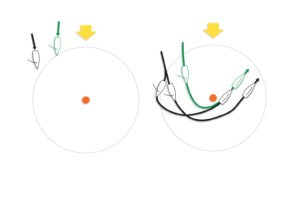After reading a draft of Mike Ingham’s latest article on mast bend for our September issue, I had the good fortune to hitch a ride with him and fellow Quantum sailmaker Tim Healy for some two-boat J/24 tuning on a beautiful afternoon in Newport, R.I. With about 10 knots of breeze and minimal chop, we set off with the end goal of the J/24 Worlds in Rochester, N.Y., in mind. Here’s how a couple of our experts made the most of their practice session:
Make a plan.
Mike and Tim wanted to fine tune straight-line boatspeed upwind and test different settings. So we went upwind (for a couple of hours), did just a handful of tacks, and motored back to the harbor at the end of the session. Their plan was specific, so we maximized our time on the water by focusing solely on that plan.
**Get the boats even first.
**Before we raised the sails, we set our sidestay and forestay tensions at base (20/15 on the J/24 with a LOOS gauge) to get the settings of the two boats close. When we got out on the water, we fine-tuned those settings upwind so that our speed and pointing were nearly identical. In addition to rig tension, we compared jib trim and jib halyard tension, the relationship of the boom to centerline, mast butt location, and weight distribution.
Switch skippers.
Once the boats were going about the same, Tim and Mike switched boats. One thing Tim noticed quickly was that Mike’s boat felt heavier. Mike had extra sails, tools, and other gear down below, so I switched over to Tim’s boat to help even up what they deemed about a “Meredith” amount of weight (although Tim admitted that he didn’t get a different feel after I left—it could have just been a different steering feel particular to the boat). Tim and Mike sailed until they felt even once again, and returned to their original boats.
**Then make adjustments.
**Keeping one boat at the base setting, we tried out different rig tensions, jib lead settings, and mast butt locations on the other boat. Trying a more outboard lead setting didn’t have much of an impact on Tim’s boat, but we also weren’t in the ideal conditions for that, which involves much more chop. Mike tried moving his mast butt forward to straighten the mast out, but ultimately found that a farther aft mast butt worked better.
Bring radios.
Being able to communicate over the radio during the straight line testing allowed us to go sail more continuously and coordinate adjustments on the boats without having to stop and regroup every time.
**Keep talking. **
The trimmers on both boats were best placed to constantly relay speed and pointing comparisons to the skippers. They kept talking throughout the session, while the crew farther forward chimed in with pertinent observations not only on speed and pointing, but also on boat set-up and wind conditions.
**Get a take-away. **
Think about what worked or didn’t work on the motor (or sail) in—Mike noted that the farther aft mast butt seemed to work well, which was something he hadn’t been expecting. Tim and Mike’s teams didn’t debrief, but planned to digest their sail overnight and regroup in the morning with some thoughts ahead of the next day’s tuning session.









